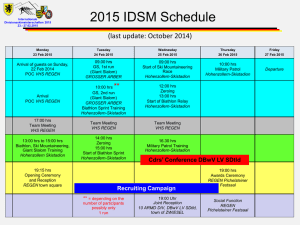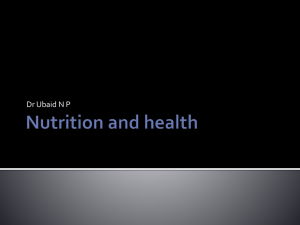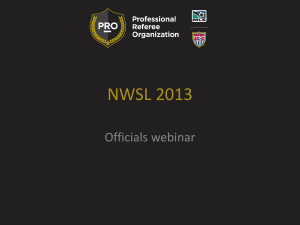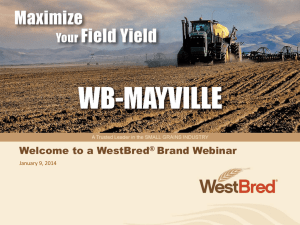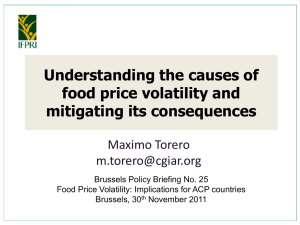Wheat Quality-Export Market-John Oades, USW
advertisement
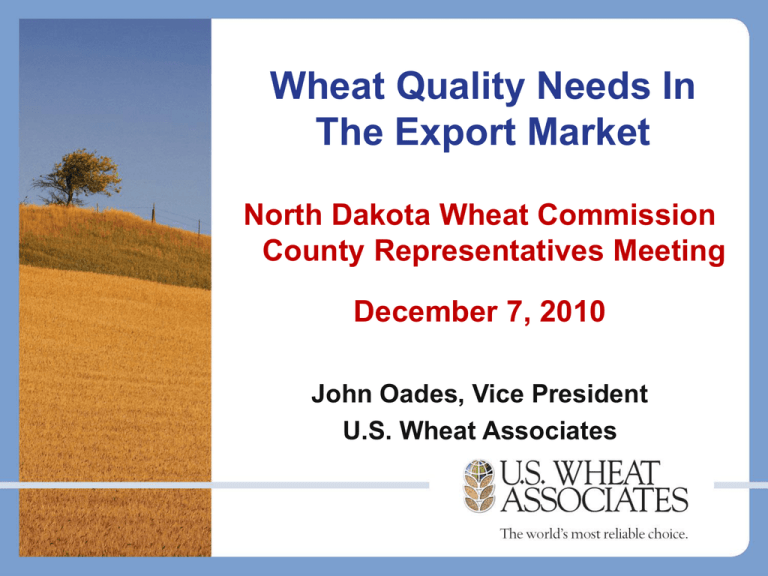
Wheat Quality Needs In The Export Market North Dakota Wheat Commission County Representatives Meeting December 7, 2010 John Oades, Vice President U.S. Wheat Associates Serving Your International Customers • As wheat growers you know the importance of your international customer base – On average 57% of U.S. HRS production is exported annually • Average HRS production is 13.0 MMT (478 mb) annually • Average HRS exports are 7.42 MMT (273 mb) annually Columbia Grain Wheat Movement to Export • HRS wheat moves to export by truck, rail and barge 35 tons 1,500 tons/barge Shuttle train: 11,000 tons HRS Exports Movements • HRS exports: By mode and location Duluth, 13% Superior St. Law. . Portland 5% Exports 7.42 MMT annually 57% Interior 5% Rail Huston, Galveston Barge/Laker New Orleans 20% Knowing Your Export Customers • In a typical year HRS exports will go to more than 150 buyers in 30 countries – Question: Buyers on which continent import the most HRS wheat? • Answer: Asia (about 55% of HRS exports) – Question: Which country is consistently the largest (#1) HRS wheat importer? • Answer: Japan (1.59 MMT or 59 mb) – Question: Which group of countries is generally the #2 buyer of HRS wheat? • Answer: The EU-27* (962 TMT or 36 mb) *Primarily Italy, Spain and the UK Knowing Your Export Customers • Our Top 10 HRS Customers (5 yr. avg.) – – – – – – – – – – Japan: 1.59 MMT (59 mb) European Un: 962 TMT (36 mb) Philippines: 950 TMT (35 mb) Taiwan: 555 TMT (20 mb) Venezuela: 440 TMT (16 mb) Korea: 384 TMT (14 mb) Mexico: 298 TMT (11 mb) Thailand: 225 TMT (8 mb) Dominican Rep: 178 TMT (6 mb) Indonesia: 132 TMT (5 MB) Knowing Your Competition • Your primary HRS competitors are: – Canada (CWRS) – Australia (APH) – Kazakhstan (?) • World markets are extremely competitive – Price, Quality and Service drive the market – Customers want VALUE: The best possible quality and service for the price paid – We are frequently “price challenged” • We therefore must provide superior quality and service to compensate for our higher prices Customer Quality Demands • Customers control quality through their contract specifications – – – – – – – – U.S. grade Wheat class/subclass Protein Moisture Dockage Falling number Vomitoxin Other (some non FGIS) • Quality & quantity assurance provided by USDA/FGIS at the export elevator Customer Quality Demands- HRS • U.S. grade: – Most customers buy U.S. #2 or better – A few customers buy exclusively U.S. #1 – Many customers contract for “above grade” quality on individual grade factors • Test weight above the #2 grade limit of 57 lbs/bu • Damaged kernels below the #2 grade limit of 4% • Shrunken & broken kernels below #2 limit of 5% • Wheat class & subclass: – Most customers buy NS/DNS (min. 25% DHV) – Some buy exclusively DNS (min. 75% DHV) – Many define a specific DHV minimum: • Minimum 50%, 55%, 60% or 65% DHV Customer Quality Demands- HRS • Protein (12% moisture basis) – Most customers buy minimum 14% protein – Some buy as high as 15% – A few buy as low as 13%, usually in low protein years (like last year and this year) • Moisture (lower moisture = higher value) – Most customers specify maximum 13.5% – Some specify as low as 12% – Several are considering “price incentive/scale” specifications for lower moisture Customer Quality Demands- HRS • Dockage (non wheat material) – Dockage specifications vary greatly based on customer view of value and wheat cleaning capability at the exporting elevator • The Lakes and PNW export elevators have wheat cleaning capacity permitting specifications as low as maximum 0.3% • Gulf of Mexico elevators do not have wheat cleaning capacity, thus HRS dockage specs range from 0.8 to 1% • Falling Number (control for sprout damage) – Most customers spec between 300 & 350 seconds minimum – A few will take lower FN’s around 250 seconds Customer Quality Demands- HRS • Vomitoxin – Most customers spec maximum 2 ppm Vomitoxin – Some spec less, as low as maximum 0.8 ppm • Other: – Limit pesticide residues – Limit mycotoxins (Zearalenone, Ochratoxin) – Phyto-sanitary limitations: plant diseases, weed seeds and insects – Thousand kernel weight minimum – Gluten functionality requirements (more to come) • Farinograph values • Alveograph values • Wet gluten &/or gluten index Japanese Quality Specifications- HRS – Class/subclass: NS/DNS – Grade: U.S. #2 or better • Sprout damage: Average not to exceed 0.3% with no sublot above 0.5% • Scab damage: Average not to exceed 0.0% • Heat damage: Average not to exceed 0.0%, no sublot above 0.2% – – – – – – – – Protein: Minimum 14.0% Moisture: Average not to exceed 13.5% Dockage: Maximum 0.3% (non deductible) Falling number: Minimum 330 per sublot Vomitoxin: Maximum 1.1 ppm (at loading 0.8 ppm) Treated seeds: No treated seeds Ergot: Average not to exceed 0.04% Residues: ppm limits on 229 chemical compounds Italian Quality Specifications- HRS – – – – – – Class/subclass: NS/DNS Grade: U.S. #2 or better Protein: No sublot below 14.0%* Moisture: Maximum 13.0% Falling number: Minimum 300 Vomitoxin: Maximum 1.0 ppm *This year taking mostly 13.5% Taiwan Quality Specifications- HRS − Class/subclass: DNS − Grade: U.S. #1 • Sprout damage: Maximum 0.5% − Protein: Minimum 14.0%, and some minimum 14.5%* − Moisture: Maximum 13.0% − Dockage: Maximum 0.3%, • Discounts apply: Dockage content 0.01-0.2% = 1:1discount Dockage content 0.21-0.3% = 2:1 discount • Ocean freight on dockage content to be reimbursed – – – – Fall number: Minimum 300 sublot average basis Vomitoxin: Maximum 2 ppm Aflatoxin: Maximum 15 ppb Residues: ppm limits on 38 chemical compounds * This year taking some NS/13 in-lieu of HRW/13 Venezuela Quality Specifications- HRS – Class/subclass: NS/DNS – Grade: U.S. Grade #2 or better • Sprout damage: Maximum 0.5% – – – – Protein: Minimum 13.5%, and minimum 14.0%* Moisture: Maximum 13.5% Dockage: Maximum 1.0%, all deductible Falling number: Minimum 300 sublot average basis – Vomitoxin: Maximum 4 ppm *This year taking 13.5% HRS Protein- 2010 Crop • HRS ‘10 crop average protein 13.7% – ND ‘10 crop average protein 13.9% (13.0% LY) • HRS five year crop average protein 14.2% – ND five year average protein 14.2% • Export demand is mostly 14% and higher • Recent export market prices PNW Gulf NS/DNS 13.0 @ $392/MT $343/MT ($10.67, $9.32/bu) NS/DNS 13.5 @ $403/MT $357/MT ($10.97, $9.72/bu) NS/DNS 14.0 @ $440/MT $383/MT ($11.97, $10.42/bu) It’s All About VALUE • NDWC efforts in promoting quality in varietal development and production are appreciated – Several states have developed “Recommended Variety List” based on wheat quality • Ratings based on multi year, multi location data – Growers are encouraged to select the best quality varieties from among those that are their top agronomic performers – This helps improve the overall quality of the crop without giving up yield • Thereby increasing Value to the customer Varieties That Make Money & Market GROWN & TESTED ACROSS NORTH DAKOTA – QUALITY & END-USE FACTORS * Quality Factors5 Ed-Use7 Test Weight LB/BU Test Wheat KG/HL Wheat Protein % Wheat Falling # Seconds Farinogram Stability (Min) Absorption % Loaf Volume CC Gluten Strength Description7 Mill & Bake Quality Rating8 Alsen 60.2 79.2 15.4 387 11.4 65.8 1009 traditional strong Barlow 61.3 80.6 14.8 394 10.0 68.8 1000 traditional strong Breaker 61.8 81.3 15.1 407 18.1 66.9 1039 traditional strong Briggs 60.5 79.6 15.0 457 11.3 66.9 964 mellow Faller 59.1 77.8 14.4 392 10.4 64.4 1013 mellow Freyr 60.2 79.2 14.7 462 12.9 67.4 1003 traditional strong Glenn 62.4 82.0 15.4 375 14.6 65.9 1056 traditional strong Howard 59.8 78.7 14.9 404 10.4 66.1 1003 traditional strong Kelby 61.1 80.4 15.3 398 9.0 67.6 966 mellow RB07 60.4 79.5 14.7 397 17.9 66.0 1054 traditional strong Reeder 60.1 79.1 15.3 408 9.5 65.3 968 mellow Steele-ND 59.7 78.6 15.0 404 10.3 66.5 993 traditional strong Vantage 62.3 81.9 16.1 351 14.4 67.3 1011 traditional strong Variety * 2010 U.S. HRS Regional Quality Report Future: Marketing Functional Quality • Currently proxies are used to represent functional quality: (dough mix properties) – Wheat class, protein, DHV – Current functionality tests to slow and complex • FGIS is working on rapid technology that will directly measure gluten functionality – Gluten strength/extensibility • If the GCA is approved for “official criteria” (optional) use: – Customers could buy specific functional quality – You could be paid for that quality Gluten Core Analyzer U.S. Wheat The World’s Most Reliable Choice It all begins with you…




